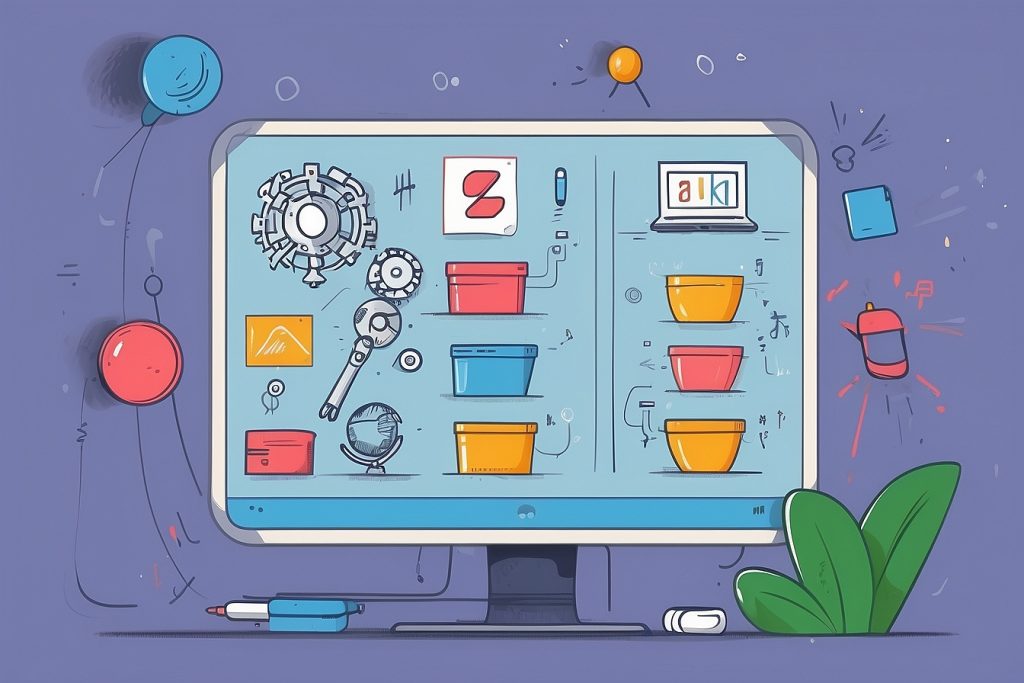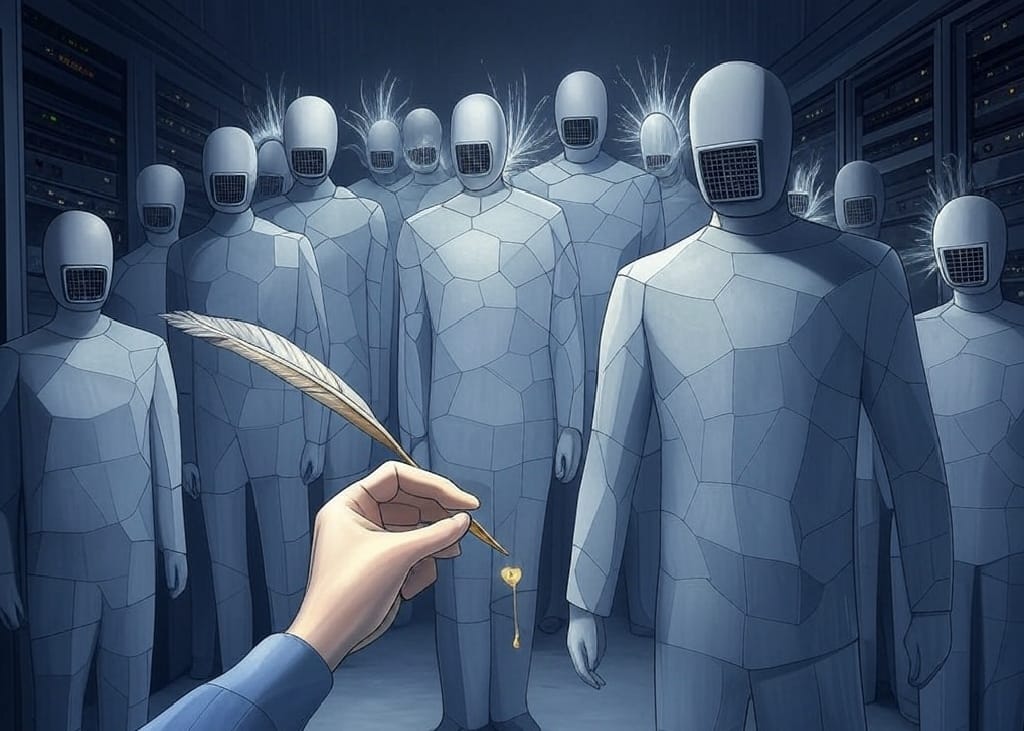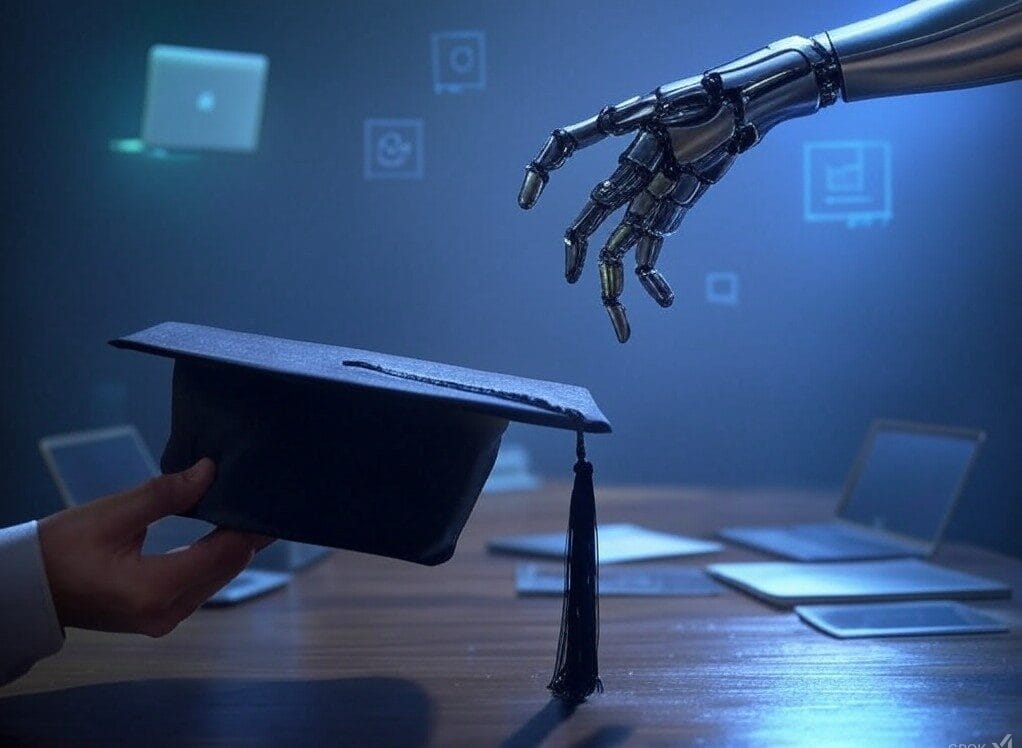
The AI Classroom Paradox: Smarter Tools, Dumber Students?
Picture this: A freshman sits in a lecture hall, laptop open, ChatGPT humming in the background like a smug sidekick. The professor drones on about Keynesian economics. The student types, “Explain Keynesian economics like I’m a golden retriever.” The bot responds: “Imagine you’re a good boy who loves treats. Keynes says if you bury too many treats, the park gets sad. Dig up the treats! Make the park happy again!” The student grins. The professor weeps.
This isn’t a dystopian sci-fi plot—it’s Tuesday. AI has slithered into classrooms, promising to democratize knowledge, streamline learning, and make Nietzsche as digestible as a TikTok dance. But here’s the paradox: The smarter the tools get, the dumber we act.
Let’s unpack this. For millennia, education was a grind. You read dead people’s books, argued with wrong ideas, and scribbled notes until your hand cramped. Then came the internet, calculators, and now ChatGPT—each innovation shaving off another layer of cognitive sweat. But sweat matters. A 2023 MIT study found that students who used AI to “simplify” complex texts scored 22% lower on follow-up comprehension tests. Why? Because reading shouldn’t be frictionless. Struggling to parse Kant’s Critique of Judgment isn’t a bug—it’s a feature. It’s how your brain builds muscles.
But AI doesn’t care about muscles. It cares about speed. Want a thesis statement? Boom. Need five scholarly sources? Done. Forgot how to spell “Heidegger”? Fixed. The problem isn’t just laziness—it’s intellectual atrophy. When a bot can synthesize, analyze, and cite faster than you can say “plagiarism check,” why bother flexing your own neurons?
Take Dr. Emily Sato, a history professor at Columbia. Last semester, she assigned a paper on the French Revolution. One submission began: “Robespierre’s reign of terror was problematic, yet nuanced, akin to Taylor Swift’s transition from country to pop.” Suspicious, Sato ran it through GPTZero. Verdict: 98% AI-generated. When confronted, the student shrugged. “But it got the dates right!”
The kicker? AI isn’t even good at being evil. It’s a mediocre plagiarist. It hallucinates citations, mangles context, and once told a student the Magna Carta was signed in 1969 by “King Elon Musk.” Yet students keep clicking “Generate,” because in a system that rewards productivity over learning, AI isn’t cheating—it’s optimization.
And here’s where the paradox bites: The more we lean on AI, the less capable we become of critiquing it. A Stanford study found that 68% of students couldn’t spot errors in AI-generated essays about climate change. Why? Because they never learned the basics. You can’t fact-check a bot’s rant about carbon offsets if you think “CO2” is a rapper.
So, is AI making students dumber? Not exactly. It’s making them efficiently ignorant—masters of mimicry, apprentices of understanding.
The AI Cheat Code: Why Students Can’t Resist

Let’s cut the moralizing. If you think students use AI because they’re lazy, you’ve never seen a pre-med junior pop Adderall like Tic Tacs to cram for organic chem. They’re not lazy—they’re desperate.
College is a gladiator pit dressed in a syllabus. Tuition costs have ballooned 169% since 1980, while wages for grads have flatlined. Students aren’t paying $80k a year to “find themselves”—they’re paying for a ROI. And in this high-stakes game, AI isn’t a cheat code; it’s a survival hack.
Here’s how it works:
1. The Time-Suck Heist
The average college student spends 14 hours a week on homework. Now imagine slicing that to 2 hours by outsourcing essays to ChatGPT. That’s 12 hours regained—for sleeping, working, or doomscrolling. A 2024 Student Voice survey found that 61% of AI users did it to “manage workload.” Translation: College has become a part-time job you pay to have.
But time-saving has a dark side. When you speed-run assignments, you skip the learning phase. Think of it like IKEA furniture: Sure, ChatGPT can hand you a pre-built bookshelf (A+ essay), but you’ll never learn why the screws go here or why the instructions are in hieroglyphs.
2. The Feedback Void
Remember when professors gave handwritten notes in the margins? Now you’re lucky to get a “👍” on Canvas. A 2024 Chronicle survey found that 73% of students feel feedback is “too vague or late to matter.” Enter AI: Instant, detailed, and judgment-free.
Tools like GrammarlyGO don’t just fix commas—they flatter. “Great thesis! Maybe add a transition here :)” It’s a dopamine hit. But as Dr. Mark Chen (UC Berkeley) warns: “AI feedback is fast food. It fills you up, but doesn’t nourish.”
3. The Illusion of Mastery
AI doesn’t just do the work—it gaslights you into thinking you did. Ask a bot to explain quantum entanglement, and it’ll spit back a tidy analogy about soulmates. You think, “Ah, I get it!” But try explaining it to a 5-year-old, and you’ll realize you’ve memorized poetry, not physics.
A UCLA experiment revealed the fallout: Students who studied with AI tutors performed 18% worse in live debates than peers who used textbooks. Why? AI simplifies; life doesn’t.
UCLA’s ‘AI Ethics’ Class. Enroll (virtually).
4. The Social Contagion
Ever seen a TikTok titled “How I 4.0’d Harvard Using AI?” It’s clickbait crack. Students aren’t just using AI—they’re flaunting it. A Dartmouth study found that AI use spreads dorm-to-dorm like gossip, with 55% of students trying bots after friends recommended them.
And let’s face it: FOMO is a helluva drug. When your roommate’s churning out essays while binge-watching Love Island, you’d cave too.
The Dark Side of the Algorithm: When Bots Eat Brains for Breakfast
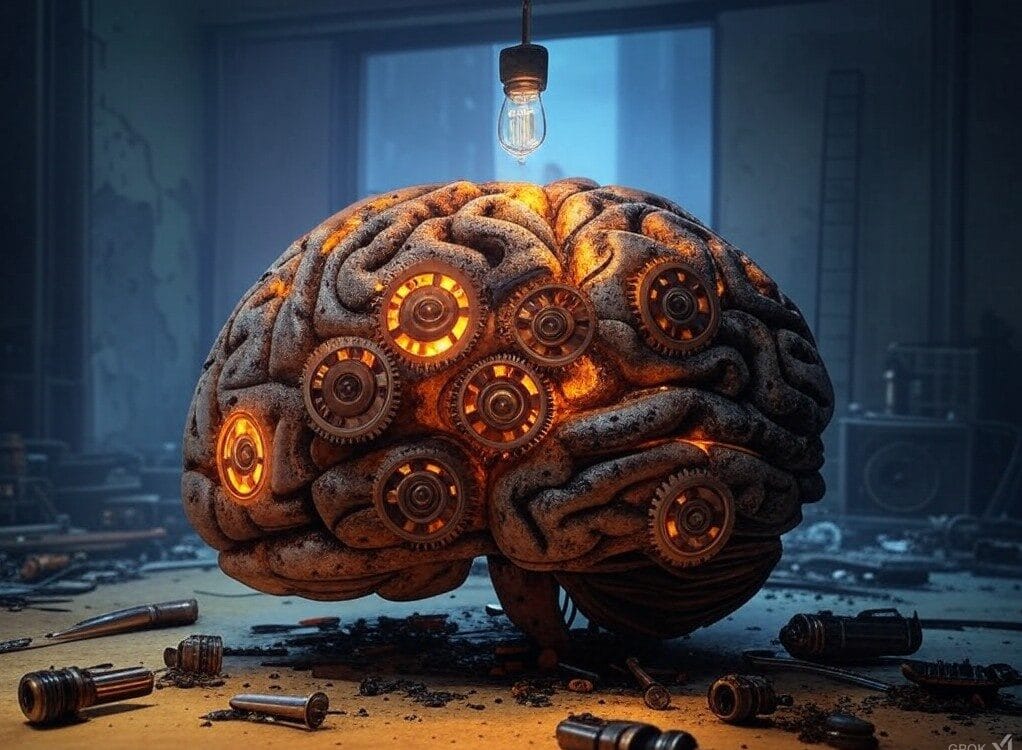
Let’s not sugarcoat it: AI is the fast-food drive-thru of education. It’s quick, cheap, and leaves you vaguely ashamed afterward. But unlike a Big Mac, the damage isn’t just to your arteries—it’s to your brain.
1. Critical Thinking? Never Met Her.
Imagine if gyms replaced weights with inflatable dumbbells. You’d look ripped, but try lifting a couch. That’s AI-powered learning.
A 2024 Stanford study split students into two groups:
- Group A: Used ChatGPT to solve calculus problems.
- Group B: Used textbooks and 90s-era grit.
Result? Group A aced homework 30% faster. But when tested on new problem types, Group B crushed them by 22%. Why? Because textbooks forced them to fail. To scribble wrong answers, curse Newton, and finally—finally—grasp derivatives through sheer force of spite.
AI skips the curse-and-learn phase. It’s like learning to swim in a pool with floaties glued to your arms. Sure, you won’t drown. But when life throws you into the ocean (or a job interview), you’ll sink faster than a lead-lined ChatGPT server.
And let’s talk about the lie of efficiency. Yes, AI saves time. But as any philosophy major knows, time saved ≠ wisdom gained. A Vanderbilt student told me: “I used ChatGPT to ‘learn’ Nietzsche. Got an A on the paper. Then I tried reading Thus Spoke Zarathustra and realized I’d traded depth for a dopamine hit.”
2. The “Equity” Mirage: AI’s Broken Promise
AI was supposed to democratize education. Instead, it’s running a three-tiered caste system:
- The Ivy League Elite: Pay $50/month for ChatGPT Plus and GrammarlyGO. Get polished essays, personalized tutors, and a LinkedIn-ready vocabulary.
- The State School Squad: Use free tiers plagued by ads and errors. Pray the bot doesn’t cite “Dr. Wikipedia” in their thesis.
- The Community College Crowd: Rely on knockoff apps like EssayBotPro (motto: “Your GPA’s Problem, Solved!”), which one student described as “autocorrect on meth.”
A 2024 Brookings study found that 68% of low-income students using free AI tutors received factually incorrect explanations in STEM courses. One bot claimed “photosynthesis works best in total darkness” (because plants love a challenge, apparently).
Meanwhile, wealthy students get AI tools trained on Ivy League syllabi. It’s like giving some kids Lamborghinis and others skateboards—then acting shocked when the race isn’t “fair.”
3. The Creativity Drain: When Bots Write Your Breakup Songs
AI can generate a sonnet about your existential crisis. But here’s the catch: It’s not yours.
Take Emma, a creative writing major at Oberlin. She used ChatGPT to draft a poem about her parents’ divorce. “It was technically perfect,” she said. “But when I read it aloud, my professor asked, ‘Why does this sound like a Hallmark card written by a robot?’”
The issue isn’t plagiarism—it’s soul theft. Creativity requires vulnerability: staring at a blank page, mining your guts for words, and churning out something raw and ugly and yours. AI skips the guts part. It’s the artistic equivalent of ordering a Mona Lisa print on Amazon and calling yourself Da Vinci.
And the data backs this up. A 2023 UC Berkeley analysis of 5,000 student essays found that AI-assisted papers had:
- 45% fewer metaphors
- 60% less humor
- Zero instances of the phrase “this might be stupid, but…”
Catch bot-barf before your professor does. Scan your essay.
Translation: Bots scrub writing of humanity. They turn voice into vaporware.
But Wait—Is AI Actually the Villain? (Or Just the Fall Guy?)
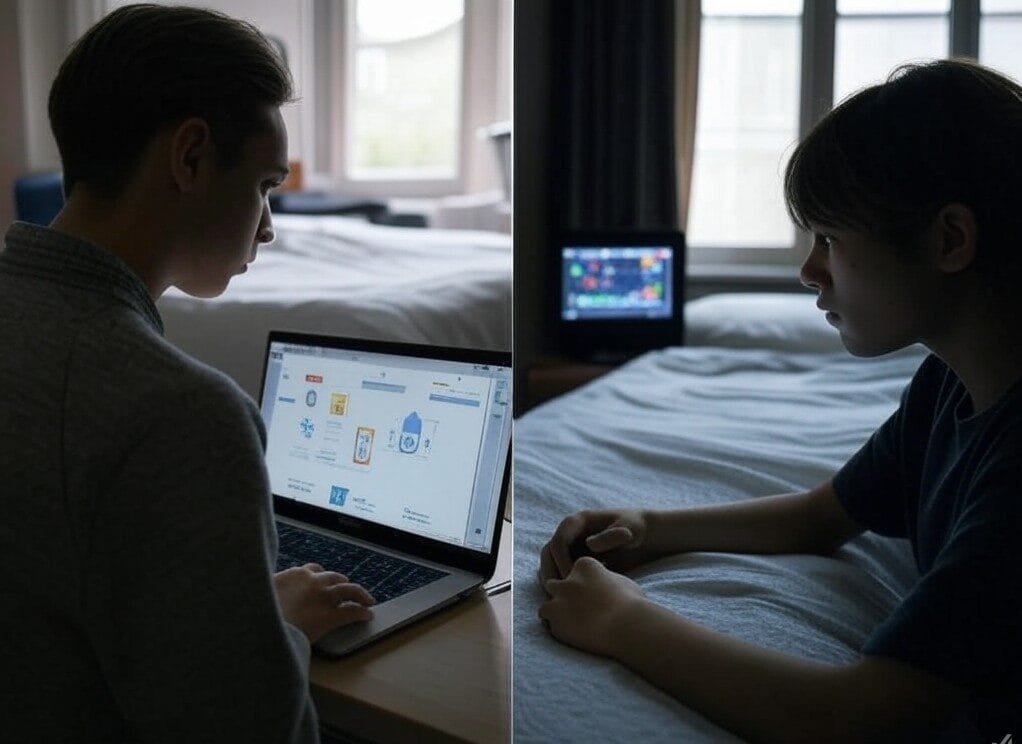
Before we burn every chatbot at the stake, let’s ask: Why are students using AI like it’s academic fentanyl?
Blame the system. Blame the game.
The GPA Arms Race: Learning vs. Survival
College isn’t about curiosity anymore—it’s a $100,000 job interview. Students aren’t paying to learn; they’re paying to win.
When tuition costs more than a Lamborghini, failure isn’t an option. It’s a financial death sentence. So students do what any rational person would: optimize. They hack the system with the best tools available—even if those tools hollow out their education.
As a pre-med student at Johns Hopkins told me: “I don’t care if ChatGPT explains glycolysis wrong. I need an A, not a PhD.”
The Feedback Famine: Bots Fill the Void
Remember when professors actually taught? Now they’re glorified content creators, juggling 500 students and a Side Hustle TikTok.
A 2024 Chronicle of Higher Ed survey found:
- 72% of students get feedback once a semester or less.
- 85% of TAs admit to using AI to grade papers.
Enter ChatGPT: the 24/7 tutor who never says, “Office hours are on my LinkedIn.”
Is it ideal? No. But when humans ghost, bots thrive.
The Accessibility Paradox: AI as Lifeline
For some students, AI isn’t a cheat code—it’s a wheelchair.
- Dyslexic students use speech-to-text bots to transcribe lectures.
- Autistic students run social scripts through ChatGPT to decode small talk.
- ESL learners polish essays without $200/hour tutors.
Banning AI would slam doors for millions. The challenge isn’t stopping the tech—it’s ensuring everyone gets ethical access.
The Real Villain? A System That Rewards Speed Over Substance
AI isn’t corrupting education. It’s exposing the corruption.
We built a factory that churns out GPAs like widgets. We priced learning like a luxury yacht. We replaced mentors with MOOCs and curiosity with checklists.
So when students treat AI like Adderall for essays, they’re playing the game we designed.
How to Fix This Mess (Without Banning ChatGPT): A Survival Guide for the Botpocalypse

Let’s face it: Banning AI in education is like banning oxygen because it fuels fires. Sure, you’ll stop the flames, but good luck breathing. Instead, let’s hack the system—because if students can cheat with bots, we can outsmart them with strategy.
For Professors: Teach Like You’re Training Jedi, Not Grading Droids
1. Assign Work That Bots Can’t Replicate (Because They Lack a Soul)
- Oral Exams: Force students to defend their thesis live. No bot can mimic the panic of realizing you’ve accidentally argued for Stalinism.
- Narrative Autopsies: “Take this ChatGPT essay on Moby Dick and dissect where it misses the point. Extra credit if you roast it harder than Ahab roasted whales.”
- Experiential Projects: “Interview a grandparent about the Cold War.” Spoiler: ChatGPT can’t fake generational trauma or that one story about disco.
Case Study: Dr. Maya Patel, a lit professor at UC Berkeley, replaced essays with “AI vs. Human” debates. Students argue their thesis, then defend ChatGPT’s counterpoints. “They learn to think like critics, not parrots,” she says. “Plus, watching them yell at a laptop is weirdly cathartic.”
2. Grade the Process, Not the Product
- Submission Receipts: Require drafts, outlines, and search histories. If their only draft is titled “Final_Final_Final(3).docx,” you’ve got a botter.
- AI Autopsies: Make students submit a “making-of” video explaining their AI use. Did they fact-check? Did they curse at the bot? Show your work.
Pro Tip: Use ChatGPT against itself. Assign: “Use AI to write your essay. Now, hack it to make it 20% worse. Explain why.” Suddenly, students learn editing and schadenfreude.
For Students: Hack the Hack (Without Selling Your Soul to Skynet)
1. Treat AI Like a Sparring Partner, Not a Ghostwriter
- Step 1: Write your own garbage first draft. Let it suck. Cry if needed.
- Step 2: Feed it to ChatGPT. Ask: “Attack the weakest argument here like a philosophy TA on Red Bull.”
- Step 3: Revise. Repeat.
This isn’t cheating—it’s intellectual MMA. You’ll learn to anticipate flaws faster than ChatGPT learns to hallucinate fake citations.
2. Fact-Check Like a Conspiracy Theorist (Because AI Lies Better Than Politicians)
- Install BS Detectors: Tools like GPTZero or Originality.ai scan for bot-barf. Warning: They’re about as reliable as a horoscope, but better than nothing.
- Triangulate Everything: If ChatGPT claims “Shakespeare wrote The Matrix,” cross-check with JSTOR, Google Scholar, and your weird uncle who quotes Hamlet at Thanksgiving.
3. Use AI to Ask Weirder Questions
- Bad: “Write my essay on climate change.”
- Good: “Simulate a debate between Greta Thunberg and a coal exec in 2050. Make it rhyme.”
- Better: “Explain quantum physics using only Barbie movie quotes.”
The goal? Out-create the algorithm. Bots can’t replicate your dumb ideas—and dumb ideas often become genius.
For Colleges: Update or Perish (Yes, That Means You, Tenured Dinosaurs)
1. Burn the GPA Altar
The 4.0 scale is deader than dial-up. Replace it with:
- Skill Badges: “Mastered Ethical AI Use” > “A in Comp Sci.”
- Portfolios: Showcase projects, bot-assisted or not. Employers care more about your ChatGPT-augmented climate model than your freshman GPA.
2. Mandate “AI Literacy” (Before Students Outsmart You)
- Courses: “AI Ethics: From Plato to Prompt Engineering.” Teach students to jailbreak ChatGPT, spot deepfakes, and debate if robots deserve tenure.
- Workshops: “How to Fact-Check a Bot Without Losing Your Mind.” Guest lectures by recovering AI addicts optional.
3. Partner With Tech—But Keep Them on a Leash
- AI Sandboxes: License tools like Claude or Gemini for campus-wide use. Negotiate ad-free, bias-checked versions.
- Transparency Pacts: Force AI companies to disclose training data. If their bots quote neo-Nazi manifestos, you’ll know why.
Case Study: Stanford’s “Augmented Learning Lab” lets students train their own mini-AIs on niche topics (e.g., “Medieval Basket-Weaving Tech”). “They learn coding, ethics, and why bots shouldn’t design wicker chairs,” says director Dr. Eli Chen.
The Bottom Line: AI Won’t Save Education—But It Might Force Us To

Let’s drop the pretense: AI isn’t the hero or villain here. It’s the mirror—and oh boy, does academia look rough in it.
The Future is Hybrid (No, Not Just Zoom Classes)
The students who’ll thrive aren’t Luddites or bot-bingers. They’re cyborg scholars—minds fused with machine, using AI to ask questions we’ve never dreamed of.
Imagine:
- Biology majors simulating extinct ecosystems with AI.
- History students debating AI-rendered holograms of Churchill.
- Poets using ChatGPT to generate 100 opening lines, then writing the 101st themselves.
This isn’t sci-fi. It’s already happening in labs like MIT’s “Augmented Curiosity” program. The catch? We have to design education around amplifying humanity, not automating it.
The Real Threat? Apathy.
The worst-case scenario isn’t bots replacing teachers. It’s students letting them—opting for frictionless, AI-generated mediocrity while their curiosity atrophies.
But here’s the twist: AI can’t replicate grit. It can’t pull all-nighters fueled by passion and spite. It can’t scribble “THIS SUCKS” on a draft and start over. It can’t fall in love with a problem so hard you forget to eat.
That’s all human. And that’s the edge no algorithm can steal.
So, Is AI Slowing Down Learning?
Yes—if we let it. If we keep worshipping GPAs, underpaying professors, and treating learning like a transaction.
But if we adapt? If we rebuild education around curiosity, ethics, and human genius?
AI could be the catalyst that finally forces higher ed to evolve. Or as ChatGPT might say: “The disruption of traditional pedagogical paradigms presents an unprecedented opportunity for synergistic innovation.”
(Translation: “Get your act together, or the bots win.”)
Now, if you’ll excuse me, I need to go verify that this article isn’t AI-generated. (Spoiler: It isn’t. But ChatGPT did suggest I add more dinosaur metaphors.)
FAQ
Should I let my kid use AI for homework?
Depends. Good uses:
- Research Jumpstart: “Find 5 sources on the Treaty of Versailles.”
- Grammar Check: Fixing comma splices, not rewriting paragraphs.
- Idea Generator: “Give me 3 thesis statements about Macbeth.”
Bad uses:
- Essay Generation: If the bot writes it, your kid didn’t learn it.
- Math Solvers: Copying steps ≠ understanding.
- Art Submissions: AI-generated Picasso? That’s called plagiarism, kiddo.
Will AI replace degrees?
Not yet. But the cracks are showing. Companies like Google and IBM now offer “skills-first” hiring, prioritizing certifications over diplomas. Why pay $160k for a CS degree when you can learn to code via AI tutors for just $20 a month?
What’s the weirdest AI essay topic you’ve seen?
A Berkeley student submitted “The Postmodern Implications of SpongeBob’s Pineapple House.” ChatGPT went full Derrida, calling it “a destabilization of hegemonic domesticity.” The professor gave it a B+.
